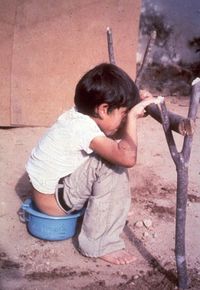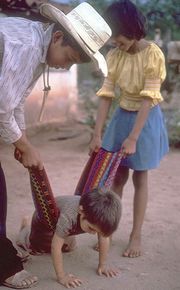Hesperian Health Guides
Putting Our New Understanding Into Practice
HealthWiki > Disabled Village Children > Chapter 47: Helping Teachers and Children > Putting Our New Understanding Into Practice
Ask the children if they know any child in the village (or in a neighboring village) who is disabled or has special difficulties in any way.
Then discuss ways that the children might be able to make friends with each child with disabilities. The children can list their suggestions of how they can all be as happy, capable, and self-reliant as possible. Later, after getting to know the child and her family better, they can change and add to their ideas.
If the child with disabilities is a family member of one of the children in the learning group, starting to do things with the child and the family may be fairly easy. But if none of the children is related to the child with disabilities, they must be careful in the way they offer their help. Probably only two or three children should make the first visit, perhaps with the help of a teacher, health worker, or rehabilitation worker.
The children, with suggestions from the child with disabilities and her family, will need to figure out ways that they can help most. However, the following list of possibilities may give you some ideas:
- Become friends—one or more children can become close companions, playmates, and friends of the child with disabilities.

- Visit the child at home—regularly!
- Help the family by doing errands, keeping the child company when family members have to leave the house, or taking the child on outings.
- Figure out a way to help the child get to and from school.
- At school, one or more children can become the “buddies” or helpers of the child with disabilities, making sure her needs are met.
- If it is impossible for the child with disabilities to go to school, children may be able to organize an after-school teaching program at the child’s home. Ask the teacher to help plan this.
- Figure out ways to include the child in games.
- Make helpful toys for the child and play together with her.
- Make a “rehabilitation playground” or “playground for all children.” Take children with disabilities regularly to the playground and play together with them there.
- Build simple playground equipment, adapted for the particular child, at her home.

- You may be able to help build aids for the children, such as crutches, sandbags, braces, or even a simple wheelchair. Try to get advice from a rehabilitation worker. If what you need to make is too difficult, perhaps the children can ask parents who are craftspersons to help. Visit them as a committee.
- Become “prevention scouts” by following these suggestions, or by taking other actions to prevent disability in your village.
- If there is a village rehabilitation center in your village, perhaps a group of children can take turns there as volunteers after school. There are many ways you can help and much you can learn. Those who show most interest can become “junior rehabilitation workers.”
Contents
Children with severe disabilities
Some children with disabilities cannot walk or swim or play many games. But sometimes these children can learn to play marbles, cards, or guessing games.
Learning is especially difficult for a child who takes longer to speak or think than other children. This child may be very lonely. Sometimes a child who cannot speak, understands a lot more than people think he does. If there is such a child in your neighborhood, perhaps children could take turns visiting him, to talk or play with him. Let him know you care.
Babies with developmental delays
Sometimes a baby will have developmental delays. The child will be later than other babies in the village to begin to sit, use her hands, crawl, walk or talk.
Babies with developmental delays need special care. If possible, their parents should get advice from a rehabilitation worker or physiotherapist. However, there is a lot that other children in the household can do.
More than almost anything else, these babies need lots of attention. They need to be played with and helped or encouraged to play. They need simple toys and colorful or noisy things to attract their attention. They need to be talked to and sung to a lot. These things will help the baby develop faster. And these are all things other children can do.
In the next activity sheet we will talk more about helping a child whose mind takes longer to develop or who has difficulty understanding.
Helping a child with disabilities learn to do new things
 |
| A simple bar held by forked sticks can increase the self reliance of a child who has difficulty squatting to poop. |
There are many ways that children can help a baby or young child with a disability to learn to do new things. Here are some ideas:
- Make it fun! If exercises can be turned into games, the child will learn faster and everyone will enjoy it more.
- Self-help. Help the child with disabilities only as much as he needs. Encourage him to do as much as he can for himself and by himself.
- Little by little. Remember, some things are especially difficult for the disabled child. Encourage her to do a little more than she already does—and then a little more. If you have her try to do too much, she may get discouraged and stop trying.
- Show you care. Show the child how glad you are when he learns to do new things. Praise him when he does well—and when he tries.
- Mind and body. Play often with the child, in ways that help her develop not only her body but also her mind. Talk with her and tell her stories Become her friend.
AN EXAMPLE: Pablo is having trouble learning to crawl. Using the above suggestions, how can we help him? Perhaps his older family members, or other children, can play “crawling games” with him.
 |
Two children can hold up part of his weight as he tries to crawl. Another child encourages him to crawl by holding out a fruit or toy. Call him to crawl toward the fruit. Praise him when he tries. Play the game every day. As Pablo grows stronger, less of his weight will need to be held up. In time he may be able to crawl without help. |
 Children in Mexico playing a crawling game. |
Note: Many more ideas of ways children can help a child with developmental delays can be found in PART 1 of this book, especially Chapter 34 and Chapter 35.
Story telling
Story telling is another good way to help young people understand the needs and possibilities of children with disabilities and what can be done to help. You can make up stories. Or better, you can base them on true events where a child with disabilities has achieved something outstanding, or where a group of children have succeeded in making an important difference in the life of a child with disabilities. The story that follows is an example.


